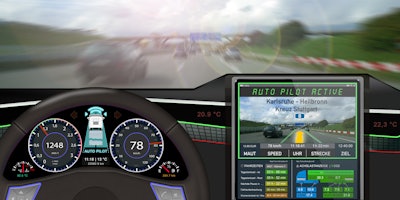
The National Safety Council reported that motor vehicle deaths are estimated to be the highest in 13 years, despite dramatic drops in miles driven due to the Coronavirus disease (COVID-19) pandemic. The preliminary estimated rate of death on the roads in 2020 spiked 24% despite miles driven dropping 13%. Despite more people working at home in what was an “off year” for driving, the fleet industry still faces a mounting risk problem. As we begin 2022, with massive supply chain hiccups and driver retention challenges, fleet managers are looking for technology advancements that can substantially improve business operations. Fleet safety technology has become a beacon of opportunity for innovative commercial carriers because it’s something that the business can exert control over -- the right safety artificial intelligence (AI) has shown near immediate results in terms of lowering risk, decreasing collisions, ROI, and most importantly, protecting the well-being of drivers.
In the new year, fleet management companies in the supply chain will start to realize the increasing importance of staying safe on the road and adopt video-based vehicle safety technology at a high level. Traditionally, the market offers video-based safety, meaning recording and sending “after the fact” reports to safety managers such as when a driver hard brakes. The major trend going forward is predictive and preventive AI that alerts drivers in real-time, in advance, to avoid collisions vs. relying on post-event reporting after an incident has occurred.
The most successful AI will limit false positives and reliably alert drivers in advance with enough critical extra seconds to reduce the risk of a potentially catastrophic event. In addition to helping prevent collisions in real-time, AI-driven alerts in the cabin, if sufficiently accurate, can automatically improve driving performance by prompting drivers to reduce risky behaviors that increase the probability of collisions. Here are 2022 trends on why this type of preventive AI will be imperative for the coming year and beyond for fleet safety in the supply chain:
Deeper understanding of risk. Understanding the true sources of collision risk is fundamental for effective prevention. Today’s typical advanced driver assist systems (ADAS) feature forward-collision and lane departure warnings but lack awareness of the driver’s state of attention. Driver monitoring systems (DMS) are able to detect this and can provide alerts to a driver when they are distracted, such as checking their phone for text messages or not paying attention to the road. More sophisticated systems are able to fuse ADAS and DMS capabilities in order to customize the behavior of forward-collision warnings based on whether the driver is distracted. Achieving the next level of risk awareness and quantification requires broader incorporation of external context and environment variables. Consider a scenario where a driver is distracted for a few seconds on an empty, rural open road with no pedestrians - the risk levels go down. However, if a driver is distracted with a combination of factors that are influenced by variables such as speeding, entering a crowded urban area with pedestrians or harsh weather - the risk of an accident increases exponentially to dangerous critical life-threatening levels. Technology that has a next layer of intelligence can determine what is important and not important – for collision avoidance and for an improved driver experience -- by fusing different risk factors, enriching context beyond basic telematics detection and single isolated events.
Next-level operational point of view. Beyond real-time detection of driver behavior in the cabin, fleet safety technology is generating tons of event data without context to the cloud and is very often overwhelming to fleet managers. Most of this data, whose volume is constantly increasing from more trucks on the road and more driving miles, is just not critical for improving safety or operations. This massive amount of data translates to higher operational costs as companies try to scale the technology across their organization by requiring more time and personnel to sift through and manage the data to discern which drivers need coaching and in what capacity, e.g. what specific behaviors need to be addressed based on the data? Technology will have a focus on addressing the true risk factors on a per driver basis and intelligently prioritizing those risk factors, as opposed to a generic bucket of risk, which will drive bottom-line results.
Predictive accident prevention. Not all risk factors equate to immediate collision risk. It is important to understand risk factors not tied to an imminent collision such as progressive drowsiness, where the driver isn’t at risk yet but could become so over time. Traditional drowsiness detection models rely on eyelid closure as the indicator that a driver is asleep or starting to fall asleep, without considering other fatigue-related behaviors that typically lead to sleep. Technology advancements will take this a step further and look at different drowsiness-related behaviors over a period of time such as yawning, blink rate/duration and shifting in the seat. The advanced AI technology will act as a co-pilot and be a preventive second line of defense in ensuring that the driver is fine to drive or might need to check out for the night and get some much-needed sleep. In parallel, a supervisor may receive a series of warnings about a particular driver enabling them to check in about the current condition of the driver and possibly advise them to take a break for a while. This sort of accident prevention might not just be limited to sleep since drivers are human; they may be having a bad day and dealing with a plethora of issues (such as health problems, family troubles, etc). These types of everyday, highly-emotional, real-life issues may also cause cognitive distraction that negatively impacts driver behavior; the technology will detect this driving behavior change, enabling the manager to signal to the driver to see if everything is nominal or if he or she may need to get off the road for an extended period of time.
Rise of the driver. The adoption rate among drivers of this preventive AI technology will ultimately be on the rise in 2022. On a macroeconomic level, the demand for more drivers means onboarding less experienced drivers quickly to address the current staffing shortage and continued supply chain woes. Fleets will need to adopt safety technology that is driver-centric, meaning it is imperative that a driver feels supported and protected by the technology and not monitored 24x7. The technology will become more intelligent and driver-friendly. With a better understanding of risk, systems will know when it is enough to warn the driver without necessarily reporting the behavior to a supervisor vs. when it is important to notify a manager of an extremely risky event. Also, it will become increasingly important to recognize and reward good driving and capture that behavior as a model for others to follow. This trend is also a win for managers as they no longer need to worry about the smaller issues and instead can focus more on the patterns of bad behaviors that may hit critical mass. The increasing success and adoption of AI technology for fleets relies on striking the right balance between driver privacy and experience and effectively managing risk.
Leveraging data for traffic flow. Municipalities and fleets across the country will want access to shared data that can create maps, optimize routes and schedules and build location-based risk models. With this information, it becomes possible to create and plan safer, alternate routes and traffic configurations that decrease accident-prone hotspots while maximizing productivity. This may include re-examining areas that include 4-way stops, tricky left turns, roads that are dangerously curved and areas that might always have busy intersections. This real-world data and driver content can also have implications on better insurance underwriting models and more effective reserve allocation strategies for larger, self-insured fleets
Despite the pandemic forcing people to work remotely and stay off the road, the risks of incidents have still been at all-time high levels. Adopting fleet management for the supply chain with predictive and preventive AI is the next evolutionary step to decrease incidents and save lives in 2022 and for years to come.



















